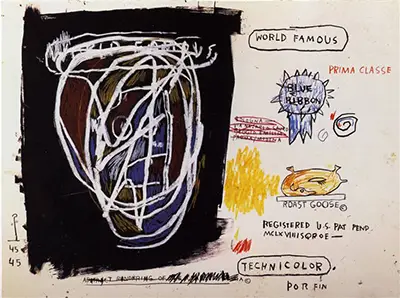Street art is random, rebellious and infographics, an approach used by neo-impressionist in the 1970s and 1980s.
Roast's Synopsis
Painted using charcoal, crayons, pastel and pencils, Roast brings social inequalities to light. The crossed-out black painting shows a creature bearing the tag World Famous. By crossing it out, Basquiat tries to show us the insignificance of such titles in society. The black background indirectly refers to black people living in the United States.
Besides the central painting is a drawing of a roasted goose, which denotes high-life. The blue ribbon badge is also an identification showing value, all pointing to the World Famous tag. Other writings, pictorials and infographics show what it means for someone to enjoy a good life and be famous.
Basquiat painted this masterpiece in 1983 at a time when he was into Robert Rauschenberg works. At 22 years, he was one of the youngest painters in his clique and more accomplished. In fact, he painted "Hollywood African" around the same time, which spoke of the rise of African Americans. Currently, the painting is part of The Daros Suite of Thirty-Two Drawnings. The original measurements are 57cm high and 76.5cm wide.
Genre
All Basquiat works of art have social meaning. The beauty of neo-impressionist street art is randomness without any standard dimensions. The drawing falls in the abstract genre, which was popular among young painters at the time. His influence at the time was Robert Rauschenberg, Torrick Alblack and Rammelizee. It was also around the same time that Basquiat started doing artiste graffiti.
Roast's Ownership
The commercial journey of Roast is not clear since there is no recorded information of who bought it after painting. However, it is currently at the Daros Collection in Zurich, Switzerland.
Similar Paintings by Jean-Michel Basquiat
The period around 1982 to 1984 saw Basquiat all over the African Movement. His paintings were suggestive and were either talking about black supremacy or inequality in America, especially in white-dominated neighbourhoods. Some of his famous paintings during this period were Cabeza (1982), History of black People (1983), Aboriginal (1984) and All Coloured Cast - Part III (1982). Roast is Jean-Michel Basquiat's way of expressing the pressure that comes with fame; good life, lovely food and recognition.


